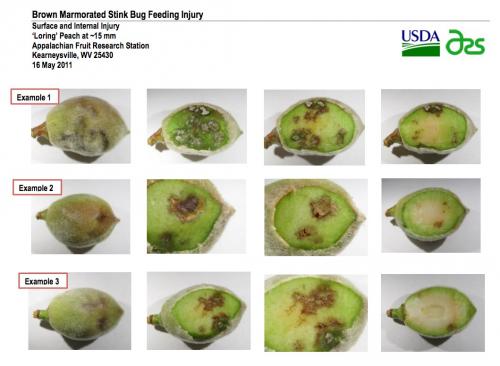Michigan brown marmorated stink bug report for July 14, 2015
No brown marmorated stink bugs were caught in traps this week. Reports of adults captured in homes continue to trickle in.
This is the second weekly report of the Michigan State University Extension brown marmorated stink bug (BMSB) monitoring network. No BMSB were captured over the past week in any of the more than 60 traps set up near crops that would be favored by this pest. Sporadic reports continue to come in of BMSB adults found in homes across southern parts of Michigan, particularly in urban-suburban areas. BMSB are known to overwinter in manmade structures and become a residential nuisance pest before they become a serious agricultural pest.
Based on what is currently known about the biology of BMSB and its favored crop and non-crop habitats, commercial fruit and vegetable plantings have been selected that are adjacent to riparian habitats, woodland, soybean fields, major transportation corridors or various combinations of these attributes. Counties being monitored in 2015 are Allegan, Antrim, Benzie, Berrien, Clare, Grand Traverse, Ingham, Ionia, Kent, Lapeer, Leelanau, Lenawee, Livingston, Macomb, Monroe, Oakland, Oceana, Ottawa and Van Buren. Traps are set up in apples, stone fruits (peaches, plums, sweet and tart cherries), blueberries, grapes, strawberries and a variety of vegetable crops. Several urban locations where BMSB were reported last year are also being monitored.
Although BMSB will feed on and cause damage to a long list of plants, they particularly like peaches. If you are a peach grower in west, southwest and southeast Michigan, keep an eye out this season, particularly in late-season varieties, for external damage that looks like dimpling and as the fruit matures, cat-facing. When you cut open these areas, internal damage will look corky and you can typically see where the insect’s mouthparts pierced the fruit. Examples of damaged, immature fruit are in the series of images below. If you suspect damage of this kind, please contact your local fruit Extension educator.

Examples of external and internal injury from brown marmorated stink bug on unripe peaches. Exterior damage will be dimpled. Internal damage looks corky and you can usually see where mouthparts pierced the fruit. Photo series by the Leskey Lab, USDA-ARS
To learn more about how to monitor for BMSB, distinguish it from other similar-looking stink bugs, what crops it favors and management strategies should populations reach the threshold where management is necessary, visit MSU’s Brown Marmorated Stink Bug website.



 Print
Print Email
Email



